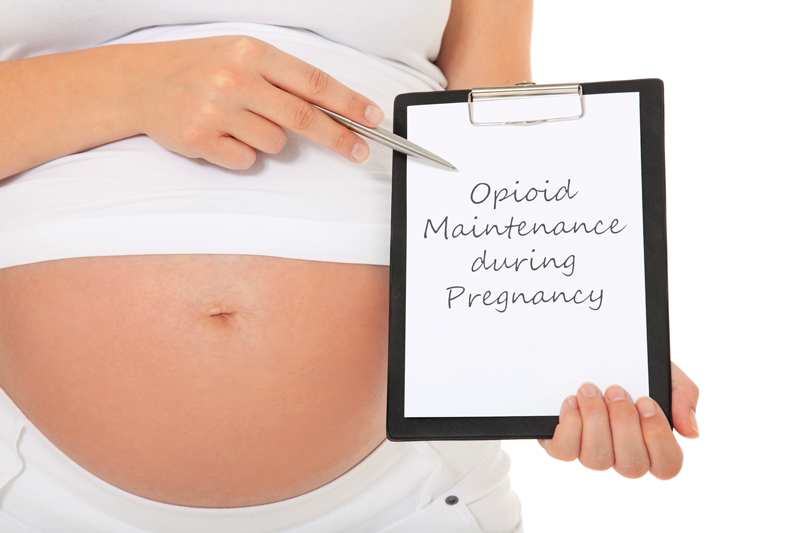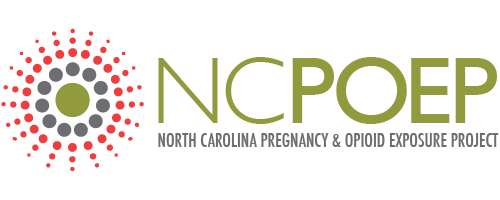Opioid Maintenance during Pregnancy
 Opioid-use disorder is a chronic disease with high rates of relapse. Acute opioid withdrawal is physiologically stressful, characterized by profound activation of the sympathetic nervous system with hypertension, tachycardia, and gastrointestinal symptoms. In the 1970s, a series of case reports of women who presented in late pregnancy with acute opioid withdrawal reported frequent occurrences of stillbirth and meconium aspiration (i.e., when a neonate inhales a mixture of the first feces and amniotic fluid).[1] Coincident with these reports, randomized trials in the general population of those with opioid dependence demonstrated that as compared with acute withdrawal, methadone maintenance decreased opioid craving and enabled rehabilitation more effectively. As methadone became accepted as appropriate medical therapy for the treatment of opioid-use disorders, the use of methadone during pregnancy to prevent maternal (and fetal) withdrawal was examined. Prescribed methadone during pregnancy improved prenatal care, reduced illicit drug use, and minimized the risk of fetal in utero withdrawal.[2] The demonstrated benefits of methadone maintenance led to the current recommendation for opioid agonist treatment for women who have an opioid-use disorder during pregnancy.
Opioid-use disorder is a chronic disease with high rates of relapse. Acute opioid withdrawal is physiologically stressful, characterized by profound activation of the sympathetic nervous system with hypertension, tachycardia, and gastrointestinal symptoms. In the 1970s, a series of case reports of women who presented in late pregnancy with acute opioid withdrawal reported frequent occurrences of stillbirth and meconium aspiration (i.e., when a neonate inhales a mixture of the first feces and amniotic fluid).[1] Coincident with these reports, randomized trials in the general population of those with opioid dependence demonstrated that as compared with acute withdrawal, methadone maintenance decreased opioid craving and enabled rehabilitation more effectively. As methadone became accepted as appropriate medical therapy for the treatment of opioid-use disorders, the use of methadone during pregnancy to prevent maternal (and fetal) withdrawal was examined. Prescribed methadone during pregnancy improved prenatal care, reduced illicit drug use, and minimized the risk of fetal in utero withdrawal.[2] The demonstrated benefits of methadone maintenance led to the current recommendation for opioid agonist treatment for women who have an opioid-use disorder during pregnancy.
Medication and Treatment Setting Options
Treatment with an opioid agonist, such as methadone or buprenorphine, improves pregnancy outcomes for women with opioid-use disorders.[3],[4] The best outcomes are achieved when women are enrolled in a comprehensive treatment program. The overarching goals of therapy for opioid-use disorders during pregnancy is to provide medical support to prevent withdrawal during pregnancy, minimize fetal exposure to illicit substances, and engage the mother as a leader in her recovery. Such engagement provides the mother with the opportunity to receive both medical and support services, which will enable her to successfully parent her child. Recognizing that engagement into a comprehensive treatment program can be a gradual process, medication providers are likely to face the difficult task of distinguishing between women who need a bit more time to become fully engaged in their treatment plan and women who are not ready for treatment. Making this distinction might require assessment of treatment progression over some weeks.
Office-based therapy with buprenorphine during pregnancy favors the woman who is highly motivated to her recovery and parenting. Women for whom office-based buprenorphine is a better fit, typically agree to participate in substance-use disorder counseling and pregnancy home visitation programs to assist in their recovery. Women who are unable to readily engage in these services may benefit from the structure of an opioid treatment program that offers methadone and/or buprenorphine along with comprehensive treatment services, which could include residential treatment. However, including substance-use disorder counseling and comprehensive, wrap-around services should be strongly encouraged for all women with opioid-use disorders because medication alone is not sufficient for optimal recovery or pregnancy and parenting outcomes.[5]
The decision regarding the most appropriate medication should be made jointly with the opioid-agonist provider, the obstetrician, and the woman. Women who are pregnant and are not a candidate for office-based buprenorphine therapy should be referred to an opioid-treatment program. In conjunction with the medication management, pregnant women should be connected to the appropriate level of treatment, ranging from outpatient treatment to residential treatment programs. An essential step in supporting an optimal recovery process is to ensure recommendations of appropriate level of treatment are matched to the patient’s individual needs and are based on a comprehensive substance-use disorder assessment using the American Society of Addiction Medicine (ASAM) criteria.



